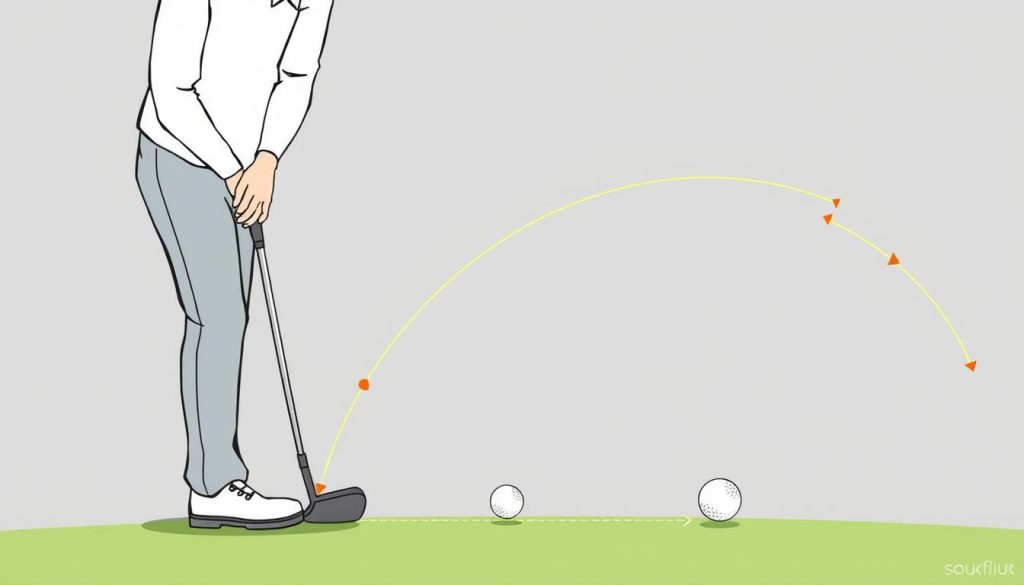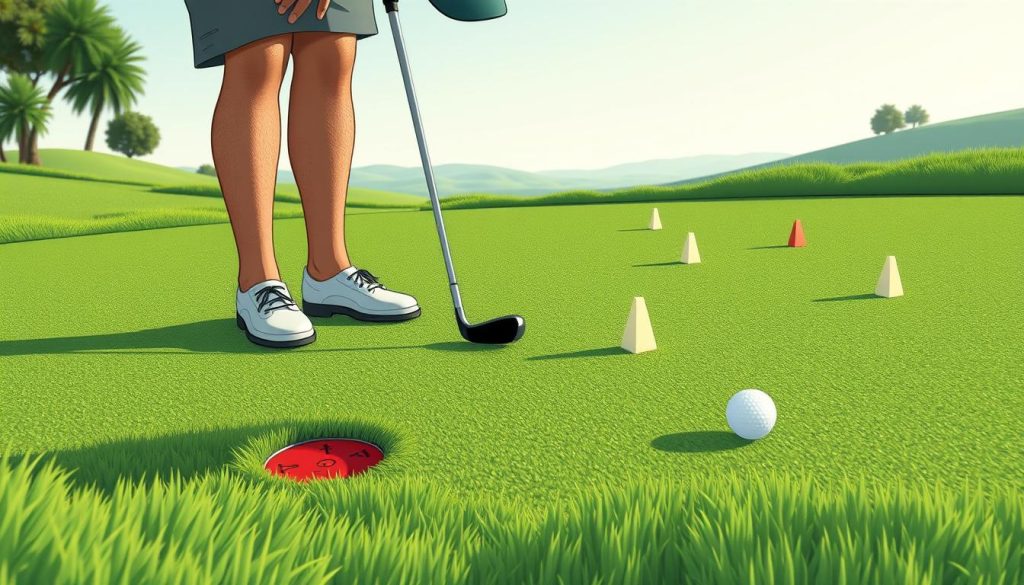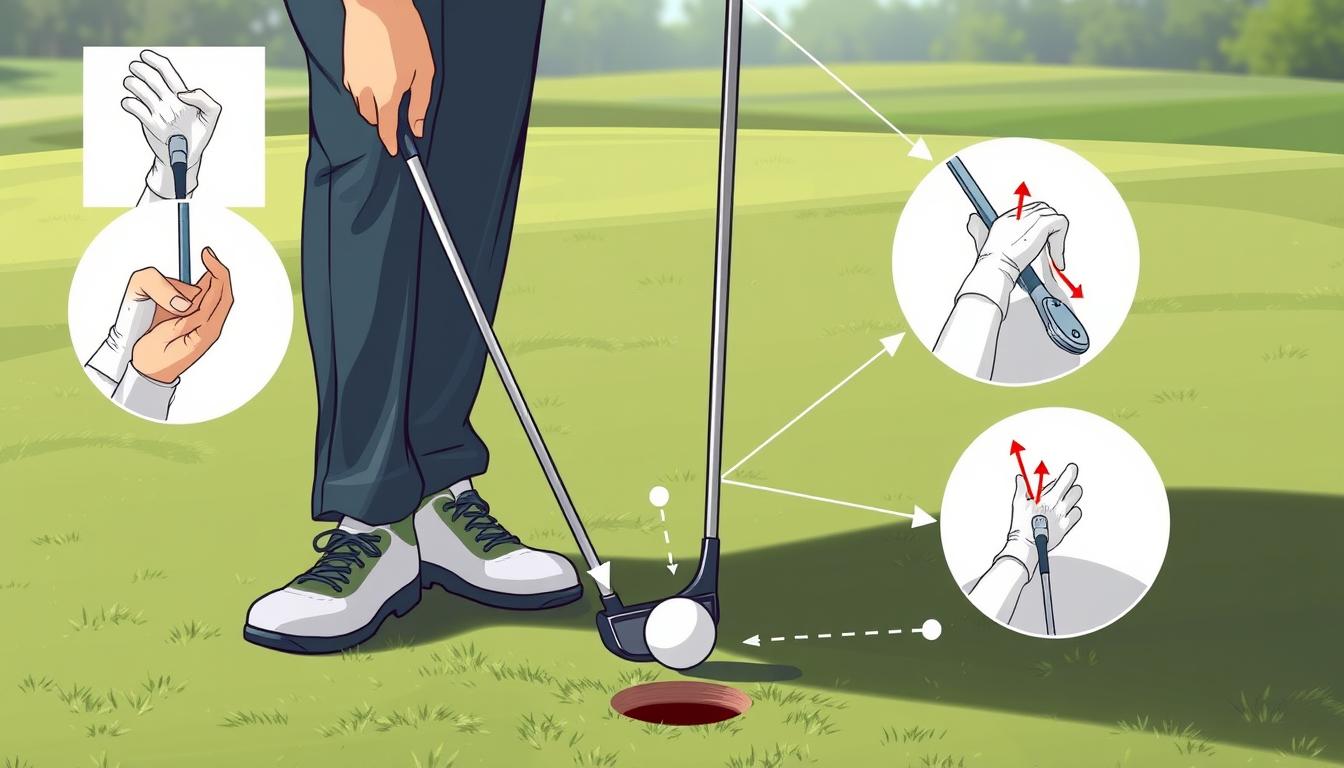Mastering putting stroke mechanics is key to lowering your golf scores. This guide dives into the essentials of golf putting technique. It helps you refine your skills on the green. By focusing on putting fundamentals, you’ll develop a consistent and effective stroke.
Studies show that even small improvements in putting can lead to significant score reductions. Top golfers spend countless hours perfecting their putting stroke mechanics. They recognize it as a crucial aspect of their game. Let’s explore the core elements that make up a successful putting technique.
Consistency is the hallmark of great putters. While each golfer’s stroke may vary slightly, maintaining a repeatable motion is vital. Factors like grip pressure, hand position, and wrist control play pivotal roles in achieving this consistency.
By fine-tuning these aspects, you’ll see a marked improvement in your putting performance.
Key Takeaways
- Consistent putting stroke mechanics are crucial for lowering golf scores
- Proper grip and hand position significantly impact stroke consistency
- Wrist control is essential for maintaining clubface alignment
- Speed, length, and tempo are key aspects of an effective putting stroke
- Regular practice of putting fundamentals leads to improved performance on the green
Understanding the Fundamentals of Putting Mechanics
Mastering putting fundamentals is key to improving your golf game. Let’s look at the main elements for a successful putt.
The Role of Body Alignment
Body alignment is crucial for accurate putting. Most golfers prefer a square setup with feet parallel to the target. This alignment helps in creating a consistent stroke path and boosts accuracy.
Grip Pressure and Hand Position
Proper grip pressure and hand position are vital for a consistent stroke. A comfortable grip with thumbs down the shaft is best. The left palm should be flat against the grip near the top of the handle. Keep your grip light for a smooth, pendulum-like motion.
Eye Position Over the Ball
Your eye position greatly affects aim and stroke path. Place your eyes just inside or directly over the ball. This ensures you see the target line clearly, leading to a more accurate stroke.
| Putting Element | Recommended Technique | Benefit |
|---|---|---|
| Body Alignment | Square setup, feet parallel to target | Improved accuracy and consistency |
| Grip Pressure | Light pressure, thumbs down shaft | Smooth, pendulum-like motion |
| Eye Position | Just inside or over the ball | Clear target line visibility |
Remember, putting is both art and science. It takes time and practice to feel confident in your stroke. Focus on these fundamentals to strengthen your putting game.
Putting Stroke Mechanics Guide
Mastering the putting stroke is key to lowering your golf scores. This guide covers the essential parts of a good putting stroke. We’ll look at the backswing, impact position, and follow-through mechanics.
Proper Backswing Technique
The backswing is the base of a consistent stroke. Keep your takeaway low and controlled. Professionals aim for a 2-1 ratio of backswing to downswing.
Try using a three-syllable phrase like “Tiger Woods.” Assign two syllables to the backswing and one to the downswing.
Impact Position Essentials
The impact position is key for consistent ball striking. Aim for a square clubface at impact, even if your setup isn’t perfect. Keep your body steady and use light grip pressure for a smoother stroke.
Brad Faxon, a putting expert, suggests a finger-based grip for better control.
Follow-through Mechanics
Your follow-through greatly affects the direction and distance of your putt. Aim for a follow-through as long as your backstroke. Lock your wrists or keep them firm for square contact with the ball.
Resist the urge to watch the ball after impact. This can disrupt your spine angle and stroke line.
| Stroke Element | Key Points |
|---|---|
| Backswing | Low, controlled takeaway; 2-1 ratio to downswing |
| Impact Position | Square clubface; steady body; light grip pressure |
| Follow-through | Equal length to backstroke; locked wrists; maintain head position |
Remember, a relaxed and confident approach to putting can greatly improve your performance. Practice these mechanics often to develop a consistent and effective putting stroke.
Mastering the Perfect Tempo
Putting tempo is the core of your golf stroke timing. A steady putting rhythm can greatly impact your game on the green. To achieve the perfect tempo, aim for a 2:1 ratio of backswing to forward swing. This means your backstroke should be twice as long as your forward stroke.
For the best putting tempo, aim for 80-95 beats per minute. This rhythm ensures precision and consistency in your strokes. Remember, golf putting is a key part of the game, and mastering your tempo is essential.
- For a 3-foot putt: Backstroke length of 4.5 inches, speed of 1.5 MPH
- For a 6-foot putt: Backstroke length of 6 inches, speed of 2 MPH
- For a 12-foot putt: Backstroke length of 8.5 inches, speed of 3 MPH
Keep your grip light and your body steady during the stroke. This helps ensure solid contact between the ball and putter head. Practice your preshot routine to improve your consistent rhythm. With practice and dedication, you’ll develop a natural, smooth tempo that boosts your putting skills.
Wrist Movement Control in Putting
Mastering wrist control in putting is key for consistent and accurate strokes. Professional golfers aim to reduce wrist movement for better results. Let’s dive into the important aspects of wrist control and how to enhance your putting technique.
Lead Wrist Position
Your lead wrist position is crucial for clubface control. For right-handed golfers, the left wrist is the lead. A firm lead wrist keeps the putter face square at impact. Focus on keeping your lead wrist flat throughout the stroke.
Preventing Wrist Break
It’s vital to prevent wrist break for a consistent stroke. Many amateurs struggle with too much wrist movement, leading to inconsistent ball striking. To avoid this, keep your wrists firm and use your shoulders to control the putter’s motion.
Maintaining Consistent Angles
Consistent angles in your stroke are crucial for accuracy. Professionals keep their wrist extension minimal during the backstroke. This leads to a more repeatable motion and better control over the putter face.
| Aspect | Amateur Golfers | Professional Golfers |
|---|---|---|
| Wrist Movement | Excessive | Minimal |
| Lead Wrist Position | Often breaks down | Remains firm and flat |
| Putter Face Control | Inconsistent | Consistent rotation |
To better your wrist control in putting, consider using tools like the HackMotion wrist sensor. This device measures your stroke’s flexion, extension, and rotation. By analyzing data from 10-15 putts, you can pinpoint areas for improvement and refine your technique.
While reducing wrist movement is important, some motion is natural and needed. Aim for a smooth, controlled stroke rather than eliminating all wrist action. With practice and focus on your lead wrist position, you can develop a more consistent and effective putting technique.
Face Control and Path Direction
Mastering putter face control and path direction is crucial for sinking more putts. The alignment of your clubface at impact greatly affects the ball’s direction. A square face sends the ball straight, while an open or closed face can cause misses left or right.
The path your putter takes also impacts accuracy. An out-to-in path with a square face pulls putts left, while an in-to-out path pushes them right. For consistent results, aim for a square path and face.
| Path | Face | Result |
|---|---|---|
| Out-to-in | Square | Pulled left |
| In-to-out | Square | Pushed right |
| Square | Open | Missed right |
| Square | Closed | Missed left |
To better your putter face control, use tools like the Back2Basics Pro Path Putting Mirror. It helps you see your stroke path and body alignment. Even pros only make about 50% of 8-foot putts, so don’t get discouraged!
For the best putting path direction, focus on three key movements. Rotate your shoulders around your spine, let your arms flow freely, and let the putter swing naturally. Keep your lower body still and let the putter’s weight guide your wrist movement through impact.
The Science Behind Stroke Arc
Understanding the putting stroke arc is key to bettering your golf game. The debate between natural arc and straight back-straight through methods is ongoing. Golfers and instructors are both interested in this topic.
Natural Arc vs. Straight Back-Straight Through
Recent studies compare arc putting stroke with the straight back-straight through method. The arc method is better for distance control on long putts. It also helps avoid putts going too far to the right.
This is especially good for right-hand dominant players. They often find the straight back-straight through method hard to master.
Finding Your Optimal Stroke Path
To find your best stroke path, try different ball and body positions. Keep your balance and tempo steady for a smooth arc stroke. Align your eyes over the ball or slightly inside the target line for better accuracy.
Practice with various backswing and follow-through lengths. This will help you find your perfect arc.
| Arc Size | Inclined Plane (degrees) | Radius (cm) |
|---|---|---|
| Small | 8 | 120 |
| Medium-Small | 12 | 120 |
| Medium | 16 | 120 |
| Medium-Large | 20 | 120 |
| Large | 24 | 120 |
Impact Point Consistency
Consistent impact points are crucial for controlling distance. Use putting gates for feedback on club face angle and start line accuracy. Inner holes have a 49mm gate width, allowing up to 0.5 degrees of error.
The middle set of holes has a 50mm gate with 0.6 degrees of error. Outer holes have a 55mm gate, allowing up to 1 degree of error.

Getting personalized advice from a golf instructor can refine your arc stroke. Embracing the natural arc can boost your putting and lower your scores.
Developing a Consistent Setup Routine
A consistent putting setup routine is crucial for better golf. Cameron Smith shows how vital a pre-putt routine is. He arrives at the practice green 90 minutes early, hitting 20-30 balls on a putting mirror. This routine makes him feel ready and confident.
To start your routine, practice short putts first. Then move to longer ones. Begin with 5-6 foot putts, then 10-15 feet, and finally up to 80-90 feet. This helps you build confidence and feel more comfortable with different distances.
A good pre-putt routine involves aligning your ball and focusing on the hole. Pros recommend this to simplify your process and prepare your mind. Visualizing successful putts before you make them is also key.
| Element | Time Spent | Focus Area |
|---|---|---|
| Arrival at Practice Green | 90 minutes before round | Overall preparation |
| Putting Mirror Practice | 20-30 balls | Stroke mechanics |
| Short Putts (5-6 feet) | 10-15 minutes | Accuracy and confidence |
| Medium Putts (10-15 feet) | 15-20 minutes | Distance control |
| Long Putts (up to 80-90 feet) | 15-20 minutes | Feel and green reading |
A consistent routine not only improves your mechanics but also your mental game. By following these steps and practicing often, you’ll have a reliable routine. This can greatly lower your scores on the green.
Advanced Stroke Techniques for Different Green Conditions
Learning to handle various green conditions is key to better scores. We’ll look at methods for uphill, downhill, and breaking putts.
Uphill and Downhill Adjustments
For uphill putting, hit the ball harder to fight gravity. Downhill, use a softer stroke to keep the ball from rolling too far. Practice these to get a feel for different slopes.
Breaking Putts Strategy
Breaking putts need careful green reading. Look at the slope and grain to figure out the break. Aim a bit above the hole for right-to-left breaks and below for left-to-right. Trust your read and stick to your line.
Speed Control Methods
Good speed control helps avoid three-putts. Use a consistent routine before your shot to judge distance and speed. Try the “clock face” method, seeing the hole as 6 o’clock and adjusting your aim.

- Practice uphill and downhill putts regularly
- Use a small target like a dime for accuracy drills
- Experiment with different stroke lengths for speed control
- Develop a consistent preshot routine for all putts
Remember, mastering these techniques takes time and practice. Spend plenty of time on the putting green to improve your skills and adapt to different conditions.
Common Stroke Flaws and Corrections
Putting is a big part of golf, making up about 40% of the game. It’s key to spot and fix putting flaws. Let’s look at common problems and how to improve your putting.
Identifying Stroke Problems
Many golfers face issues with push putts. These can be due to looking up too soon or having a long backstroke. These problems can cause the putter face to open up at impact.
Another common issue is not releasing the putter head properly. This can lead to blocks to the right.
Correction Techniques
To fix these flaws, keep your eyes on the ball through impact. Shorten your backstroke to help speed up your stroke. Practice releasing the putter head naturally to square the face at impact.
Using video analysis can help you see where to improve your stroke.
Practice Drills for Improvement
Here are some drills to improve your putting:
- Straight-Back Straight-Through Path Drill: Use alignment sticks to guide your stroke path.
- Arc Putting Stroke Drill: Practice maintaining a consistent arc throughout your stroke.
- 12 to 18″ Distance Control Drill: Focus on speed control for better accuracy.
By regularly practicing these drills and working on your putting technique, you’ll get better. Remember, practice is key to mastering putting!
| Common Flaw | Correction | Practice Drill |
|---|---|---|
| Early head movement | Keep eyes on ball through impact | Spot putting drill |
| Too long backstroke | Shorten backstroke | Pendulum drill |
| Lack of club release | Practice natural release | Gate drill |
Conclusion
Mastering putting stroke mechanics can greatly improve your golf score. Focus on consistent putting technique for better results. Your mental game is just as important as your physical skills.
This guide helps both new and experienced golfers. It covers everything from grip to eye position. Drills like the Gate Drill and Distance Control Drill help improve your stroke. It also focuses on helping golfers build consistency and confidence on the green. By incorporating putting stroke drills for accuracy, players can refine their technique and better align their shots. With regular practice, these drills can transform your short game and lower your scores significantly.
Practice is key, not just how often but how focused. Try different putters to find the right one. Use technology like putting mats and drills to enhance your practice. Remember, improving your putting takes time and effort. Stay committed to consistent practice, and you’ll see your scores drop.
FAQ
Why is consistency more important than overall quality in putting stroke mechanics?
How does wrist motion affect putt consistency?
What are the key aspects to focus on in putting stroke mechanics?
How important is body alignment in putting?
What grip does Brad Faxon recommend for putting?
How should the backswing be executed in a putting stroke?
What is the ideal tempo ratio for putting strokes?
How can I improve my putting tempo?
Why is it important to control wrist movement during putting?
How does putter face control affect putting accuracy?
Is a straight back-straight through putting technique recommended?
How can I develop a consistent setup routine for putting?
How should I adjust my stroke for uphill and downhill putts?
What are some common putting stroke flaws and how can I correct them?
How can visualization improve my putting performance?
Source Links
- https://hackmotion.com/putting-stroke-tips/
- https://golfinsideruk.com/putting-technique-the-putting-stroke-explained/
- https://practical-golf.com/putting-tips
- https://skillest.com/blog/master-the-art-of-golf-putting-a-comprehensive-guide-for-beginners/
- https://swingtrainer.com/blogs/instruction/putting-stroke-technique-tips?srsltid=AfmBOophlXIv_uq4G1HVf5q7-ii2R8IS7pToVsGZJlSD-8uhZ_-cSDUB
- https://www.pga.com/archive/basics-putting?srsltid=AfmBOophwCJ_BGkCweErBV_sLS40PreyjFX1oWPWBAnGQNGVxkbdeAbO
- https://skillest.com/blog/putting-like-brad-faxon-tips-to-improve-your-putting-stroke/
- https://us.humankinetics.com/blogs/excerpt/putting-techniques?srsltid=AfmBOopmETZSemUOMQbhMMCPx_unbWFEZ7Ffta-Nb_CRnLkenBt9EjmH
- https://back2basics.golf/blogs/news/how-to-nail-your-distance-control-and-putting-stroke?srsltid=AfmBOoqysaa7CUN90mWCR9dTvzgSQ8IR1OG52XKLhcuOlDCYRKkP6G_3
- https://www.golfzongolf.com/blog/technology/the-art-of-putting-in-golf-a-comprehensive-guide
- https://us.humankinetics.com/blogs/excerpt/putting-techniques?srsltid=AfmBOoqIo392kzkm-PDwlQzUCXvaW2wl8i7jbJnDn5XSoCaMGd7YxMDC
- https://hackmotion.com/wrist-action-in-putting/
- https://bestgolfdrills.com/blog/biomechanics-of-a-simple-putting-stroke/
- https://back2basics.golf/blogs/news/how-to-nail-your-distance-control-and-putting-stroke?srsltid=AfmBOooY6H5_z0A4BbfKGAT5bFCHdisEaMJ3QPhhuBtIxyTmg2XHG5Qy
- https://rotaryswing.com/golf-instruction/putting/perfect-putting/perfect-putting-technique-stroke
- https://face-on-putting.com/basic-setup/
- https://golf-info-guide.com/putters/arc-putting-stroke/
- https://visioputting.com/mi-putting-template-black/
- https://golf.com/instruction/putting/cameron-smith-pre-round-putting-routine-tips/
- https://hackmotion.com/how-to-become-consistent-in-golf/
- https://puttingworld.com/putt-for-par/
- https://back2basics.golf/blogs/news/how-the-pro-path-putting-mirror-transforms-your-game?srsltid=AfmBOope-7cUs3AleHnu7Q21kdcdXyG6PDoo8VX2nV0xeeotNTbXOx0R
- https://primeputt.com/blogs/golf/best-indoor-putting-drills?srsltid=AfmBOorUazs0ZjcMgtEnr30SjkXekjHKmPkGYfy5uGA4nLa8-_3BiBJR
- https://paddlerezine.com/the-guide-stroke/
- https://golf-info-guide.com/video-golf-tips/find-the-mechanical-flaws-in-your-golf-putting-stroke-video/
- https://twoputtpro.com/blogs/putting-ball-and-drills/better-putting-stroke?srsltid=AfmBOooVwDpM_Od0jdTKnM_rTkLpNQLBAMwja_L9vRurcJUUUj3LUXbC
- https://cattailcrossing.ca/blog/how-to-putt-better/


